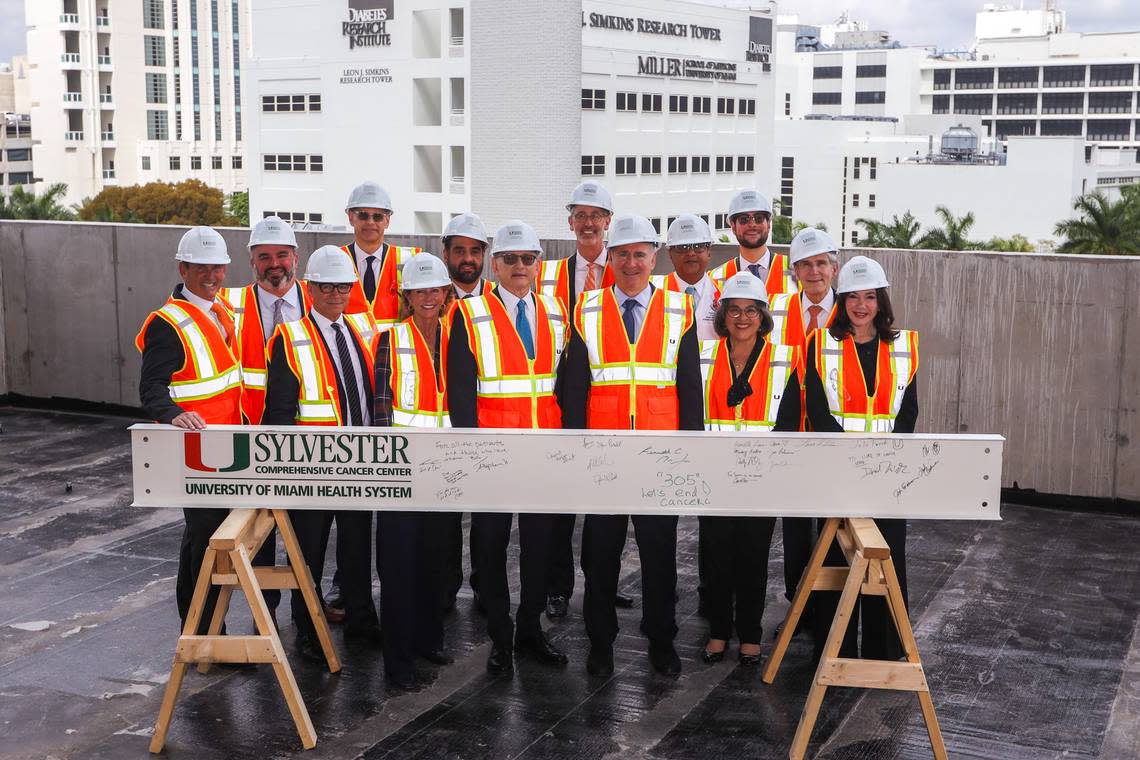A world without cancer: We can get there from here

Could the end of cancer be within our reach? Increasingly, experts express confidence that we are nearing an inflection point in the fight against the disease. Eradication of some forms of cancer, and powerfully effective new treatments for other types, are within reach now and more could happen in our lifetimes.
As the only cancer center in South Florida designated by the National Cancer Institute (NCI), Sylvester Comprehensive Cancer Center, part of the University of Miami Health System and the Miller School of Medicine, is steadfast in its commitment to prevail. Its luminary experts, alongside those at other esteemed institutions, are determined, and this resolve is bolstered by the influx of new resources and powerful therapies driven by rapid technological advancements.
In Miami, a transformative new location is nearing completion. Sylvester’s Kenneth C. Griffin Cancer Research Building at the University of Miami medical campus will be a gift of light and hope; a state-of-the-art research and clinical care facility that will allow researchers and clinicians to dramatically accelerate progress against cancer. Slated to open in 2025, its impact will benefit people in South Florida, Latin America, the Caribbean and beyond. It will help experts at Sylvester save more lives.
“What we have been building together is not just the building,” said Dr. Stephen Nimer, director at Sylvester and the Oscar de la Renta Endowed Chair in Cancer Research. “It’s a symbol of our shared commitment to turning our vision into reality — a place where we can continue to push the boundaries of what’s possible, not only for the 6.2 million people who live in South Florida but for our nation and beyond. Together, we are continually building a destination cancer center with world-renowned physicians and researchers committed to excellence, and with skilled and dedicated staff who deliver compassionate, life-saving care.”
CANCER TOUCHES EVERYONE’S LIFE
Some two million Americans will be diagnosed with cancer this year and an estimated 611,000 will die from the disease, according to the American Cancer Society. And yet, modern medicine has turned a corner in the fight against cancer. Over the last 30 years, the risk of dying from cancer has steadily declined. Today, there are 18 million cancer survivors in the United States, according to the National Cancer Institute. This progress can be substantially explained by advancements in smoking cessation, early cancer detection and treatment options.
Enter the Griffin Cancer Research Building, a transformational project that will accelerate the discovery of cancer cures. Rising against the backdrop of Downtown Miami, the glass and steel structure will soar 12 stories when completed. The $250-million facility will contain a quarter million square feet of space, doubling the research footprint of Sylvester. It will dramatically expand the number of clinical trials available for patients, beyond more than 300 trials currently underway at Sylvester.
Leveraging Miami’s significant rise in technology, the Griffin Cancer Research Building will serve as a hub for innovation and collaboration. This enhanced teamwork will accelerate the translation of groundbreaking scientific discoveries into innovative, life-saving treatments and therapies for patients, and the sharing of transformative results with other people across the world.
A visionary new facility, the building combines innovative treatment with a commitment to patient care and cures.
It is unique because it brings patients and researchers under one roof, moving potential cures from the lab bench to the patient’s bedside faster, so people receive treatment they may not otherwise have.
BUILDING EQUITY AND HOPE
Florida has the second highest cancer burden in the country, according to the state’s Department of Health. While cancer deaths overall are in decline, more people are getting certain cancers, and people of color, in particular, suffer a disproportionate burden. For example, Black men have the highest overall cancer death rate, with increased mortality for multiple myeloma and prostate cancer. Hispanic people have lower rates of some common cancers, such as breast and prostate, compared to non-Hispanic whites, but they have increased mortality for brain tumors and high rates of infection-related cancers.
Cervical cancer incidence, caused by HPV infection, is 35% higher in Hispanic women than in White women. Black women with endometrial cancer have a death rate that is twice as high as White women despite similar incidence of the disease, partly because they are diagnosed later.
Sylvester prioritizes efforts to ensure the most effective cancer treatments are available for all at-risk populations in South Florida and beyond. The Griffin Cancer Research Building will advance Sylvester’s research focused on creating the best outcomes for all patients.
LIGHTING A BEACON
The building will allow Sylvester to give the gifts of light and hope to patients and their loved ones. Light, because this new facility will pull together more scientists working to illuminate pathways to cures. Hope in the form of a growing and dynamic cancer center focusing on more effective and less toxic treatments and more cures, making Sylvester a destination cancer center that is at the forefront of cancer research and treatment.
Among the 18 million cancer survivors in the United States, Miami-Dade resident Iliana Suarez said she can’t wait to see what new research will develop because of Ken Griffin’s $50 million gift to support the new building.
“I’m cancer-free for six years now, and I owe it all to the dedication and caring attitudes of the doctors and nurses at Sylvester,” Suarez said. “I’m sure Ken’s (Griffin) gift will only lead to better lives for many other people who are fighting the disease.”
To explore giving opportunities for the Kenneth C. Griffin Cancer Research Building, visit TheSylvesterPursuit.com


